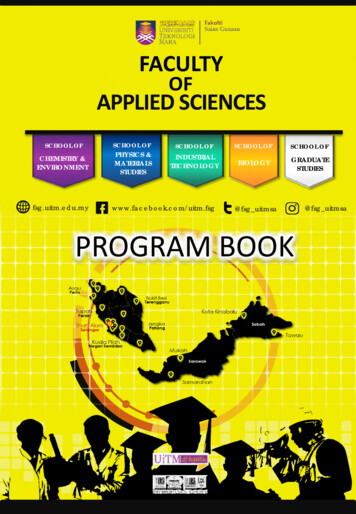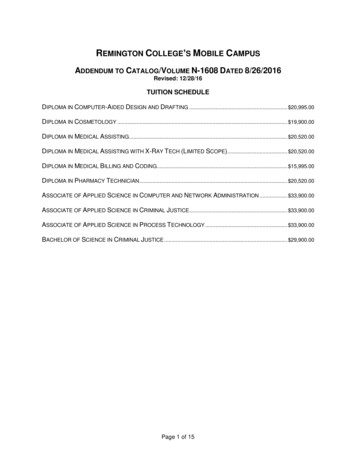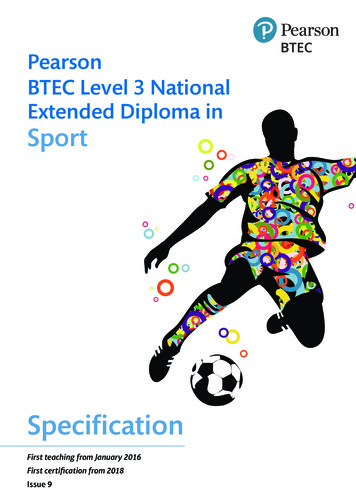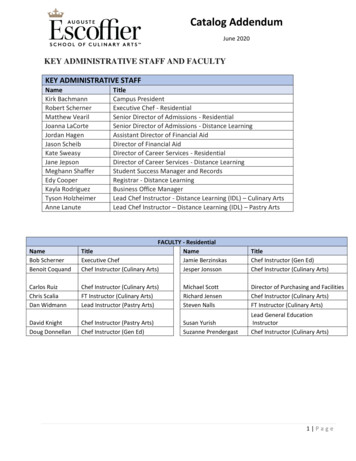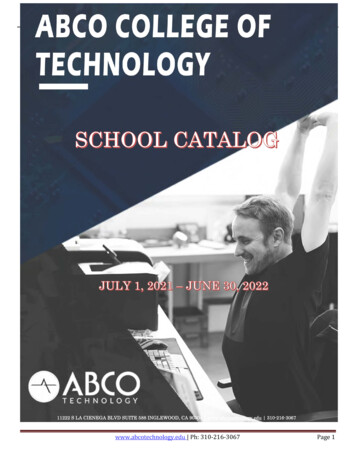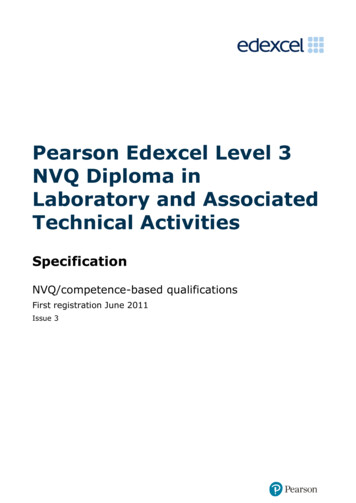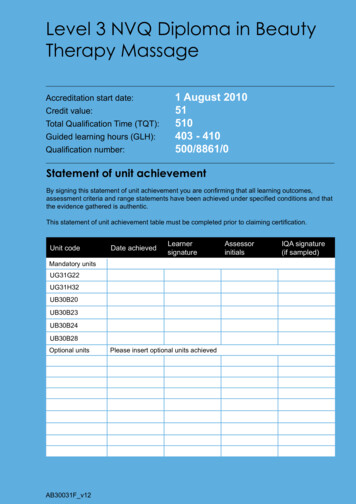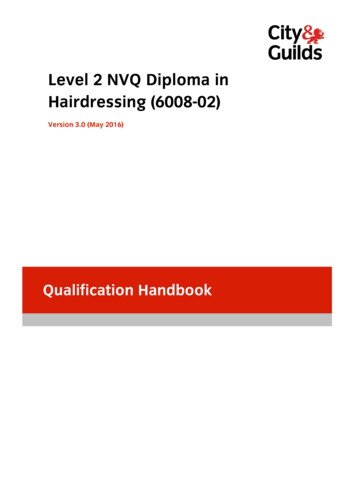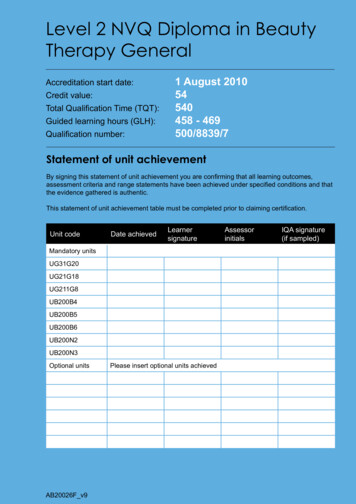
Transcription
Level 2 NVQ Diploma in BeautyTherapy General1 August 2010Credit value: 54Total Qualification Time (TQT):540Guided learning hours (GLH):458 - 469Qualification number: 500/8839/7Accreditation start date:Statement of unit achievementBy signing this statement of unit achievement you are confirming that all learning outcomes,assessment criteria and range statements have been achieved under specified conditions and thatthe evidence gathered is authentic.This statement of unit achievement table must be completed prior to claiming certification.Unit codeDate achievedLearnersignatureMandatory 00N2UB200N3Optional unitsAB20026F v9Please insert optional units achievedAssessorinitialsIQA signature(if sampled)
The qualificationIntroductionThe Level 2 NVQ Diploma in Beauty TherapyGeneral is a job ready qualification based onNational Occupational Standards (NOS).National Occupational Standards (NOS)This qualification has been mapped tothe relevant NOS, and is regulated on theRegulated Qualifications Framework.This qualification will provide you with theThis qualification is approved and supported byrequisite knowledge, understanding and skillsthe Hairdressing and Beauty Industry Authority(HABIA), the standard setting body for hair,to work competently as a beauty therapist.Throughout this qualification you will ensurebeauty, nails and spa qualifications.responsibility to reduce risks to healthand safety, promote additional services orproducts to clients, develop and maintain youreffectiveness at work, provide facial skincarePrerequisitetreatment, enhance the appearance of eyebrowsand lashes, carry out waxing services andLearners who wish to undertake thisprovide pedicure and manicure services.qualification must also achieve the VTCT(ITEC) Level 2 Award in Infection PreventionYou will be supervised by technical staff and(COVID-19) for Beauty Therapy and Nailassessed on your occupational competence.Services qualification or a regulated equivalent.2
ProgressionThis is an approved qualification for working asa beauty therapist in a salon. It also provides asound platform for further learning or training.This qualification provides progressionopportunities to the following VTCTqualifications: Level 3 NVQ Diploma in Beauty TherapyGeneral Level 3 NVQ Diploma in Beauty TherapyMassage Level 3 NVQ Diploma in Beauty TherapyMake-upProgression opportunities also exist in theform of specialist VTCT vocationally relatedqualifications at Levels 2 and 3.3
Qualification structureTotal credits required - 54 (minimum)All mandatory units must be completed.Mandatory units VTCT unitcodeOfqual unitreferenceUnit titleUG31G20A/601/5867UG21G18Credit valueGLHEnsure responsibility for actions to reducerisks to health and safety438D/601/0936Promote additional products or services tocustomers640UG211G8M/600/1268Develop and maintain effectiveness atwork330UB200B4M/600/8754Provide facial skin care treatment868UB200B5H/600/7455Enhance the appearance of eyebrows andeyelashes545UB200B6Y/600/9087Carry out waxing services761UB200N2Y/600/7551Provide manicure services653UB200N3H/600/8766Provide pedicure services653Credit valueGLHOptional units -445 credits9 (minimum) creditsVTCT unitcodeOfqual unitreferenceUnit titleUB200S1K/600/8784Assist with spa operations437UB20B10M/600/8947Enhance appearance using skincamouflage646UB200B7D/600/9088Carry out ear piercing220UB200B8F/600/8936Provide make-up services647UG211G4Y/600/1264Fulfil salon reception duties324UB20B34F/602/2089Provide threading services429
Guidance on assessmentThis book contains the mandatory units that make up this qualification. Optional units will beprovided in additional booklets. Where indicated, VTCT will provide assessment materials.Assessments may be internal or external. The method of assessment is indicated in each unit.Internal assessment(any requirements will be shown in the unit)Assessment is set, marked and internallyquality assured by the centre to clearlydemonstrate achievement of the learningoutcomes. Assessment is sampled by VTCTexternal quality assurers.External assessment(any requirements will be shown in the unit)Once these papers have been achieved allunit external papers titled ‘Paper 2 of 2’ can besigned off by your assessor.This only applies to mandatory units in thisqualification. Paper 1 of 1 and Paper 2 of 2must be completed for all optional units (whereapplicable).Assessment explainedExternally assessed hard-copy question paperswill be set by VTCT, marked by centre staff andsampled by VTCT external quality assurers.VTCT qualifications are assessed and qualityassured by centre staff. Work will be set toimprove your practical skills, knowledge andunderstanding. For practical elements, you willbe observed by your assessor. All your workmust be collected in a portfolio of evidence andcross-referenced to requirements listed in thisrecord of assessment book.External anatomy and physiologypapersYour centre will have an internal quality assurerwhose role is to check that your assessmentand evidence is valid and reliable and meetsVTCT and regulatory requirements.Externally assessed question paperscompleted electronically will be set and markedby VTCT.Some units in this qualification contain a Paper2 of 2, which assess anatomy and physiologyonly.Rather than complete an individual anatomyand physiology paper (Paper 2 of 2) for everyunit, you can complete one external paper thatcovers all anatomy and physiology papers inthis qualification.The external paper titles in Linx2Achieve are: NVQ 2 General Beauty Route - MandatoryAnatomy and Physiology (Paper 1 of 2).NVQ 2 General Beauty Route - MandatoryAnatomy and Physiology (Paper 2 of 2).An external quality assurer, appointed byVTCT, will visit your centre to sample andquality-check assessments, the internal qualityassurance process and the evidence gathered.You may be asked to attend on a different dayfrom usual if requested by the external qualityassurer.This record of assessment book is yourproperty and must be in your possession whenyou are being assessed or quality assured. Itmust be kept safe. In some cases your centrewill be required to keep it in a secure place.You and your course assessor will togethercomplete this book to show achievement of alllearning outcomes, assessment criteria andranges.5
Creating a portfolio of evidenceAs part of this qualification you are required toproduce a portfolio of evidence. A portfolio willconfirm the knowledge, understanding and skillsthat have been learned. It may be in electronicor paper format.Your assessor will provide guidance on how toprepare the portfolio of evidence and how toshow practical achievement, and understandingof the knowledge required to successfullycomplete the qualification. It is this bookletalong with the portfolio of evidence that willserve as the prime source of evidence for thisqualification.Evidence in the portfolio may take the followingforms: Observed workWitness statementsAudio-visual mediaEvidence of prior learning or attainmentWritten questionsOral questionsAssignmentsCase studiesAll evidence should be documented in theportfolio and cross referenced to the outcomes.Constructing the portfolio of evidence should notbe left to the end of the course.6
Unit assessment methodsThis section provides an overview of the assessment methods that make up each unit in thisqualification. Detailed information on assessment is provided in each unit.Mandatory unitsExternalVTCT unitcodeUnit signmentsEnsure responsibility for actions toreduce risks to health and safety0 UG21G18Promote additional products orservices to customers0 UG211G8Develop and maintain effectivenessat work0 UB200B4Provide facial skin care treatment2 UB200B5Enhance the appearance ofeyebrows and eyelashes1 UB200B6Carry out waxing services2UB200N2Provide manicure services2UB200N3Provide pedicure services2 Optional unitsExternalVTCT unitcodeUnit signmentsAssist with spa operations1 UB20B10Enhance appearance using skincamouflage1 UB200B7Carry out ear piercing1UB200B8Provide make-up services2UG211G4Fulfil salon reception duties0UB20B34Provide threading services1 7
Unit glossaryDescription8VTCT productcodeAll units are allocated a unique VTCT product code for identification purposes.This code should be quoted in all queries and correspondence to VTCT.Unit titleThe title clearly indicates the focus of the unit.NationalOccupationalStandards(NOS)NOS describe the skills, knowledge and understanding needed to undertake aparticular task or job to a nationally recognised level of competence.LevelLevel is an indication of the demand of the learning experience; the depth and/orcomplexity of achievement and independence in achieving thelearning outcomes.Credit valueThis is the number of credits awarded upon successful achievement of all unitoutcomes. Credit is a numerical value that represents a means of recognising,measuring, valuing and comparing achievement.GuidingLearning hours(GLH)The activity of a learner in being taught or instructed by - or otherwiseparticipating in education or training under the immediate guidance or supervisionof - a lecturer, supervisor, tutor or other appropriate provider of education ortraining.Totalqualificationtime (TQT)The number of hours an awarding organisation has assigned to a qualification forGuided Learning and an estimate of the number of hours a learner will reasonably belikely to spend in preparation, study, or any other form of participation in education ortraining. This includes assessment, which takes place as directed - but, unilke GuidedLearning, not under the immediate guidance or supervision of - a lecturer, supervisor,tutor or other appropriate provider of education or training.ObservationsThis indicates the minimum number of observations required to achieve the unit.LearningoutcomesThe learning outcomes are the most important component of the unit; they set outwhat is expected in terms of knowing, understanding and practicalability as a result of the learning process. Learning outcomes are the results oflearning.EvidencerequirementsThis section provides guidelines on how evidence must be gathered.Maximumservice timesThe maximum time specified by Habia in which a particular service orpractical element must be completed.ObservationoutcomeAn observation outcome details the practical tasks that must be completed toachieve the unit.KnowledgeoutcomeA knowledge outcome details the theoretical requirements of a unit that mustbe evidenced through oral questioning, a mandatory written question paper orportfolio of evidence.AssessmentcriteriaAssessment criteria set out what is required, in terms of achievement, to meeta learning outcome. The assessment criteria and learning outcomes are thecomponents that inform the learning and assessment that should take place.Assessment criteria define the standard expected to meet learning outcomes.RangeThe range indicates what must be covered. Ranges must be practicallydemonstrated in parallel to the unit’s observation outcomes.
UG31G20Ensure responsibility for actions toreduce risks to health and safetyThis unit is about providing you with the knowledge,understanding and skills to be responsible for health andsafety in the workplace.This unit is for everyone at work (whether paid, unpaid, fullor part-time). It is about being aware of the main risks inyour workplace and knowing how to identify and deal withthem.UG31G20 v8
NOSG20Level3Credit value4GLH38Observations2External paper(s)0
Ensure responsibility for actions toreduce risks to health and safetyLearning outcomesOn completion of this unit you will:1.Be able to identify the hazards and evaluatethe risks in the workplace2.Be able to reduce the risks to health andsafety in the workplace3.Evidence requirements1.A variety of assessment methods should beused to confirm competence. Assessmentof knowledge should be integrated withthe assessment of performance whereverpossible and appropriate.2.Your assessor will observe you on twoseparate occasions. All evidence must bederived from performance in the workplacewith no exceptions. Therefore no simulatedworking conditions have been specified inthis Assessment Strategy as the outcomescan be demonstrated by a combination ofother assessment methods drawn from:Know how to reduce risks to health andsafety in the workplace direct observation of the candidate in theworkplace witness testimony by colleagues and linemanagers of the candidate’s successfulperformance of activities in the workplace documentary and other product basedevidence a personal report by the candidateendorsed by colleagues questions discussion professional discussion.3.There is no external paper requirement forthis unit.UG31G2011
Achieving observationsand rangeAchieving observation outcomesYour assessor will observe your performanceof practical tasks. The minimum numberof observations required is indicated in theevidence requirements section of this unit.Criteria may not always naturally occur duringa practical observation. In such instances youwill be asked questions to demonstrate yourcompetence in this area. Your assessor willdocument the criteria that have been achievedthrough oral questioning.Your assessor will sign off an outcome when allcriteria have been competently achieved in asingle client service.Achieving rangeThere are no range statements that apply to thisunit.12UG31G20Maximum service timesThere are no maximum service times that applyto this unit.
ObservationsOutcome 1Be able to identify the hazards and evaluate the risks in theworkplaceYou can:a.Identify workplace instructions that arerelevant to you and your job roleb.Identify working practices and hazards inthe workplace that could be harmfulc.Evaluate the hazards and prioritise in riskorderd.Report hazard(s) to the responsible person**May be assessed through oral questioning.Observation12Criteria questioned orallyDate achievedPortfolio referenceLearner signatureAssessor initialsUG31G2013
Outcome 2Be able to reduce the risks to health and safety in theworkplaceYou can:a.Perform work activities at own level ofcompetence in accordance with identifiedhealth and safety:-workplace policies-relevant legal requirementsinstructions and proceduressuppliers’ and manufacturers’informationb.Manage hazards in accordance withworkplace instructions and legalrequirementsc.Report any differences between workplaceinstructions and supplier/manufacturerinstructions**May be assessed through oral questioning.ObservationCriteria questioned orallyDate achievedPortfolio referenceLearner signatureAssessor initials14UG31G2012
Developing knowledgeAchieving knowledge outcomesYou will be guided by your tutor and assessoron the evidence that needs to be produced.Your knowledge and understanding will beassessed using the assessment methods listedbelow:Where possible your assessor will integrateknowledge outcomes into practical observationsthrough oral questioning. Observed work Witness statements Audio-visual media Evidence of prior learning or attainment Written questions Oral questions Assignments Case studiesUG31G2015
KnowledgeOutcome 3Know how to reduce risks to health and safety in the workplaceYou can:a.Explain your responsibility in remaining alert to hazards and risksb.Describe own responsibilities and scope for action in controllingriskc.Explain the importance of adhering to health and safety policiesand practicesd.Describe where and when to get additional health and safetyassistancee.Describe the importance of personal presentation and behaviour inmaintaining health and safety in the workplace* Assessor initials to be inserted if orally questioned.Requirements highlighted in white are assessed in the external paper.16UG31G20Portfolio reference /Assessor initials*
UG21G18Promote additional services orproducts to clientsServices or products are continually changing in salonsto keep up with client’s expectations. By offering new orimproved services and products your salon can increaseclient satisfaction. Many salons must promote these to beable to survive in a competitive world. It is equally importantfor salons that are not in competitive environments toencourage their clients to try new services or products.This unit is all about your need to keep pace with newdevelopments and to encourage your clients to take aninterest in them. Clients expect more and more servicesor products to be offered to meet their own growingexpectations. They need to be made aware of what isavailable from your salon to give them a greater choice.UG21G18 v5
NOSG18Level2Credit value6GLH40Observations3External paper(s)0UG21G18
Promote additional services orproducts to clientsLearning outcomes4.On completion of this unit you will:1.Be able to identify additional services orproducts that are available2.Be able to inform clients about additionalservices or products3.Be able to gain client commitment to usingadditional services or products4.Understand how to promote additionalservices or products to clients use of services or products that are newto your client additional use of services or products thatyour client has used before.5.Your evidence should be collected whencarrying out a real job, whether paid orvoluntary, and when dealing with realclients, whether internal or external to thesalon. However, for this unit, evidencecollected in a realistic working environmentor a work placement is permissible.Simulation is not allowed for anyperformance evidence with this unit.2.You may collect the evidence for the unitthrough work in a private sector salon, anot-for-profit salon or a public servicessalon.3.You must provide evidence that showsyou have done this over a sufficient periodof time with different clients on differentoccasions for your assessor to be confidentthat you are competent.Your evidence must show that you: follow salon procedures for offeringadditional services or products to yourclients create opportunities for encouragingyour clients to use additional services orproducts identify what your client wants by seekinginformation directlyEvidence requirements1.You must provide evidence that theadditional services or products offeredinclude: identify what your client wants fromspontaneous client comments.6.Your communication with clients may beface to face, in writing, by telephone, textmessage, e-mail, internet, intranet or by anyother method you would be expected to usewithin your job role.7.There is no external paper requirement forthis unit.UG21G1819
Achieving observationsand rangeAchieving observation outcomesYour assessor will observe your performanceof practical tasks. The minimum numberof observations required is indicated in theevidence requirements section of this unit.Criteria may not always naturally occur duringa practical observation. In such instances youwill be asked questions to demonstrate yourcompetence in this area. Your assessor willdocument the criteria that have been achievedthrough oral questioning.Your assessor will sign off an outcome when allcriteria have been competently achieved in asingle client service.Achieving rangeThere are no range statements that apply to thisunit.20UG21G18Maximum service timesThere are no maximum service times that applyto this unit.
ObservationsOutcome 1Be able to identify additional services or products that areavailableYou can:a.Update and develop your knowledge of yourorganisation’s services or productsb.Check with others when they are unsure ofa new service or product detailsc.Identify appropriate services or productsthat may interest your clientd.Spot opportunities for offering yourcustomer additional services or productsthat will improve your clients experience*May be assessed through oral questioning.Observation123Criteria questioned orallyDate achievedPortfolio referenceLearner signatureAssessor initialsUG21G1821
HabiaOutcome 2Be able to inform clients about additional services or productsYou can:a.Choose the most appropriate time to informyour client about additional services orproductsb.Choose the most appropriate method ofcommunication to introduce your client toadditional services or productsc.Give your client accurate and sufficientinformation to enable them to make adecision about the additional services orproductsd.Give your client time to ask questions aboutthe additional services or products*May be assessed through oral questioning.ObservationCriteria questioned orallyDate achievedPortfolio referenceLearner signatureAssessor initials22UG21G18123
HabiaOutcome 3Be able to gain client commitment to using additional servicesor productsYou can:a.Close your discussion appropriately if yourclient shows no interestb.Give relevant information to move the situationforward when your client shows interestc.Secure client agreement and check clientunderstanding of the delivery of the serviceor productd.Take action to ensure prompt delivery of theadditional services or products to your cliente.Refer your client to others or to alternativesources of information if the additionalservices or products are not yourresponsibility*May be assessed through oral questioning.Observation123Criteria questioned orallyDate achievedPortfolio referenceLearner signatureAssessor initialsUG21G1823
Developing knowledgeAchieving knowledge outcomesYou will be guided by your tutor and assessor onthe evidence that needs to be produced. Yourknowledge and understanding will be assessedusing the assessment methods listed below: Observed work Witness statements Audio-visual media Evidence of prior learning or attainment Written questions Oral questions Assignments Case studies24UG21G18Where possible your assessor will integrateknowledge outcomes into practical observationsthrough oral questioning.
KnowledgeOutcome 4Understand how to promote additional services or products toclientsYou can:a.Describe the organisation’s procedures and systems forencouraging the use of additional services or productsb.Explain how additional services or products will benefit your clientsc.Explain how your clients’ use of additional services or products willbenefit your organisationd.Identify the main factors that influence clients to use your servicesor productse.Explain how to introduce additional services or products to clientsoutlining their benefits, overcoming reservations and agreeing toprovide the additional services or productsf.State how to give appropriate, balanced information to clientsabout services or productsPortfolio reference /Assessor initials** Assessor initials to be inserted if orally questioned.Requirements highlighted in white are assessed in the external written paper.UG21G1825
NotesUse this area for making notes and drawing diagrams26UG21G18
UG211G8Develop and maintaineffectiveness at workThis unit is about taking responsibility for improving yourperformance at work and working well with your colleaguesso as to make a positive contribution to the overalleffectiveness of your salon.UG211G8 v6
NOSG8Level2Credit value3GLH30Observations1External paper(s)0 Habia
Develop and maintaineffectiveness at workLearning outcomesOn completion of this unit you will:1.Be able to improve personal performance atwork2.3.Be able to work effectively as part of a team4.Understand how to improve yourperformance5.Understand how to work with othersUnderstand salon roles, procedures andtargetsEvidence requirements1.Simulation is not allowed for anyperformance evidence within this unit.2.You will need to demonstrate in youreveryday work that you have met thestandard for developing and maintainingyour effectiveness at work.3.You will need to collect ‘paper evidence’(also known as documentary evidence)to show that you have participated indevelopment activities at work.4.Your assessor will observe yourcontributions to effective teamwork on atleast 1 occasion which will be recorded.5.From the range statement, you must showthat you: have participated in all the listedopportunities to learnhave agreed and reviewed yourprogress towards both productivity andpersonal development targetshave offered assistance to both anindividual colleague and in a group ofyour colleagues.6.Although some of the evidence of yourperformance will be gathered fromobservations made by your assessor, youwill need to put together more documentaryevidence in your portfolio to support yourachievement of this unit.7.There is no external paper requirement forthis unit.UG211G829
Achieving observationsand rangeAchieving observation outcomesYour assessor will observe your performanceof practical tasks. The minimum numberof observations required is indicated in theevidence requirements section of this unit.Criteria may not always naturally occur duringa practical observation. In such instances youwill be asked questions to demonstrate yourcompetence in this area. Your assessor willdocument the criteria that have been achievedthrough oral questioning.Your assessor will sign off an outcome when allcriteria have been competently achieved in asingle client service.Achieving rangeThe range section indicates what mustbe covered. Ranges must be practicallydemonstrated as part of an observation. Yourassessor will document the portfolio referenceonce a range has been competently achieved.30UG211G8Maximum service timesThere are no maximum service times that applyto this unit.
ObservationsOutcome 1Be able to improve personal performance at workYou can:a.Identify own strengths and weaknesses anddiscuss them with the relevant person(s)and seek feedback from relevant peopleabout how to improve own performanceb.Find out more information from relevantpeople to perform a task when theinstructions are unclear*c.Ask colleagues for help and takeopportunities to learn when they areavailable or seek help from relevant peoplewhen you are unable to obtain learningopportunities relating to own work*d.Regularly review developments inhairdressing and related arease.Agree realistic work targets with the relevantperson(s), review own progress towardsachieving agreed targets and use the resultsof the reviews to develop own personaldevelopment plan*May be assessed through oral questioning.Observation1Criteria questioned orallyDate achievedPortfolio referenceLearner signatureAssessor initialsUG211G831
HabiaOutcome 2Be able to work effectively as part of a teamYou can:a.Agree ways of working together to achieveobjectives, ask for help and informationfrom own colleagues when necessary, andrespond to requests for assistance fromcolleagues willinglyb.Anticipate the needs of others and promptlyoffer assistance within own capabilities andmake effective use of the time throughoutown working dayc.Report problems likely to affect salonservices to the relevant person(s) promptlyand accurately*d.Be friendly, helpful and respectfulwith colleagues and resolve anymisunderstandings with colleagues at thetime they happen*May be assessed through oral questioning.ObservationCriteria questioned orallyDate achievedPortfolio referenceLearner signatureAssessor initials32UG211G81
RangeYou must practically demonstrate that you have:Participated in all the opportunities to learnPortfolio referenceFrom colleagues and other relevant peopleActive participation in training and development activitiesActive participation in salon activitiesAgreed and reviewed your progress towards both targetsPortfolio referenceProductivityPersonal developmentOffered assistance to both types of colleaguePortfolio referenceOn a one-to-one basisIn a groupUG211G833
Developing knowledgeAchieving knowledge outcomesYou will be guided by your tutor and assessoron the evidence that needs to be produced.Your knowledge and understanding will beassessed using the assessment methods listedbelow: Observed work Witness statements Audio-visual media Evidence of prior learning or attainment Written questions Oral questions Assignments Case studies34UG211G8Where possible your assessor will integrateknowledge outcomes into practical observationsthrough oral questioning.
KnowledgeOutcome 3Understand salon roles, procedures and targetsYou can:a.Describe your job role and responsibilities and explain thestandards of behaviour that are expected of you when working inthe salonb.Explain how to get information about your job, own workresponsibilities and how this relates to the role of other teammembersc.Explain how to find out relevant information about other people’sareas of responsibilityd.Explain the questioning and listening skills you need in order tofind out informatione.Describe the limits of your authority and that of others in relation togiving assistancef.Describe why it is important to work within your job responsibilitiesand what might happen if you do not do sog.List the commercially viable range of times for the performance ofservices offeredh.Explain the importance of meeting work and productivity targets,development targets and timescalesi.Explain how to manage your time effectivelyPortfolio reference /Assessor initials** Assessor initials to be inserted if orally questioned.Requirements highlighted in white are assessed in the external paper.UG211G835
HabiaOutcome 4Understand how to improve your performanceYou can:a.Explain how to identify your strengths and weaknessesb.Describe the importance of continuous professional developmentand how it affects your job rolec.Explain who can help you identify and obtain opportunitiesfor personal development/training and how using the NationalOccupational Standards can help you identify development needsd.Explain how to access information on National OccupationalStandards and qualifications, how to maintain awareness ofcurrent and emerging trends and developments wit
This book contains the mandatory units that make up this qualification. Optional units will be provided in additional booklets. Where indicated, VTCT will provide assessment materials. Assessments may be internal or external. The method of assessment is indicated in each unit. Internal assessment (any requirements will be shown in the unit)

